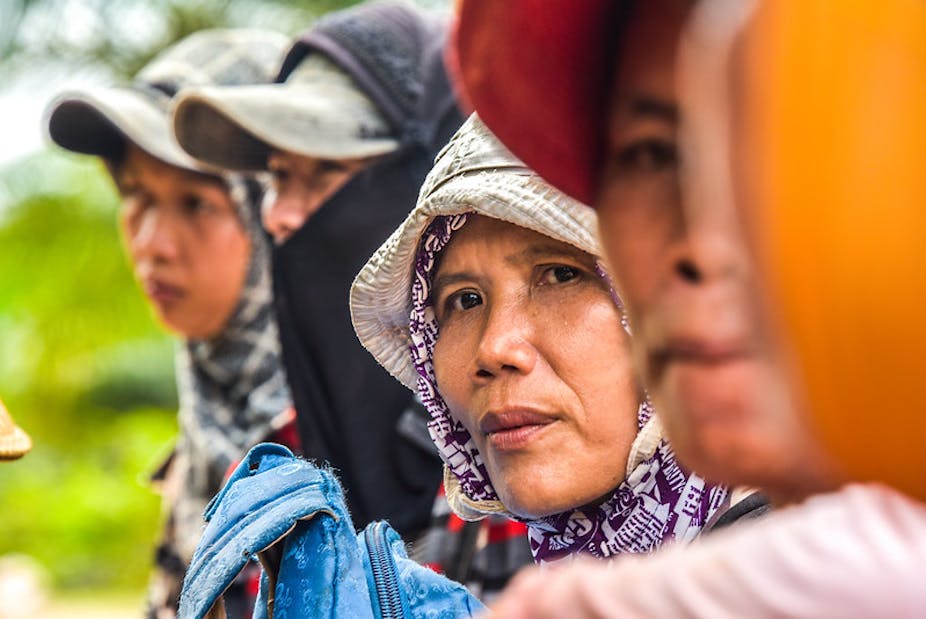One of the big hurdles for gender equality is the gap in workforce participation between men and women. In most countries, fewer women than men have jobs.
In Indonesia, female labour participation has stalled at 50% for the past 30 years. This is a bit of a mystery because Indonesia’s economy has grown constantly over this period. Education levels for women have been increasing, as have government investments in health.
In most countries, women’s participation in the workforce has grown with the economy and education levels. This is true in developed nations like Australia – where 62% of working-age women have jobs – and in developing countries such as China, Cambodia and Thailand.
It’s important that women have the opportunity to work if they want to do so. Working can help address other inequalities, such as income and in household decision-making.
According to a recent estimate by Statistics Indonesia, women made up half the population of Indonesia last year, or to more than 130 million women. It makes sense to have as many women as possible contributing to the economy, especially as the same estimates projected that there would be 149.19 million women compared to 149.17 million men by 2032, the first time the number of women surpasses men in Indonesia.
Our research, recently profiled in a Melbourne Institute Research Insight, Female Labour Force Participation in Indonesia: Why Has it Stalled?, is trying to understand why more women aren’t doing paid work in Indonesia.
What’s keeping women out of work?
Several factors are preventing women from working in Indonesia.
One is urbanisation as jobs are shifting out of the agricultural sector to manufacturing and services. Agriculture is one of the biggest sources of employment for women in Indonesia, so this shift means fewer jobs are available for them.
Another significant factor is family.
In other countries, women usually take up work after finishing their education and the number of women working reaches a peak soon after that point. When they have kids, many women drop out of the labour market, but soon after they pick it up again and continue working. In many cases, women choose to stay at work on a part-time basis, allowing them to keep their skills up to date.
But, in Indonesia, we found that after women finish their education, a large proportion don’t enter the workforce. They stay out because they are anticipating starting a family.
As a result, many women are late entering the labour force. Around 70% of working-age women with jobs are aged 45. This is a very late age to see a peak in female labour force participation.
Another factor at play in Indonesia is the divide between the formal and informal sectors. Informal jobs are unregulated – think “cash-in-hand” work – and are where the majority of women work. We thought women working in the formal sector might go into the informal sector when they had children because it offers more flexibility. This is not the case.
In reality, women leaving the formal sector left work altogether. This suggests companies in the formal sector aren’t doing enough to retain these women and help them to return to work after having children.
A final contributing factor is the gender wage gap. In Indonesia, women with high-earning jobs on average make 13% less than men in similar jobs. The gender wage gap is even larger in low-earning jobs where women earn about 63% less on average than their male counterparts.

What can Indonesia do?
Increasing the proportion of women in work in Indonesia by 10 percentage points has the potential to increase the country’s GDP growth by around 1 percentage point. While that doesn’t sound like much, this corresponds to an increase in GDP of US$123 billion, or US$432 per person. That would be significant in a developing country that is trying to move from a low-to-middle-income to a high-middle-income country.
It is in Indonesia’s interest to give more women the opportunity to work. There are two key policies that Indonesia could put in place to make the workforce more open to women.
The first is policies that encourage shared child-rearing responsibilities, such as parental leave. We know from other countries, particularly in Scandinavia, that paternity leave, alongside maternity leave, can encourage more women into the workforce.
The second policy is flexible work like part-time jobs. Current labour laws in Indonesia restrict flexible work to contract workers and freelancers. Extending flexible work arrangements to full-time workers, or allowing part-time jobs with full employee entitlements, would allow women to raise children and work at the same time. Workplaces could also provide childcare at work.
This article is co-published with Pursuit.


